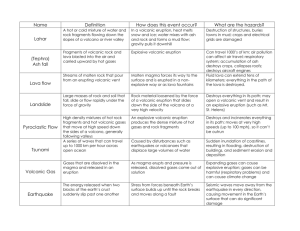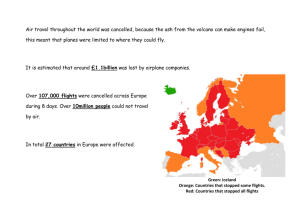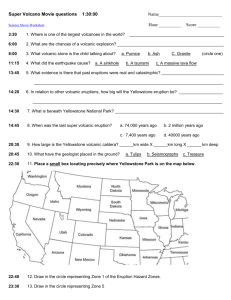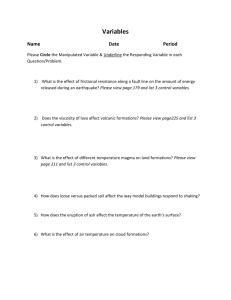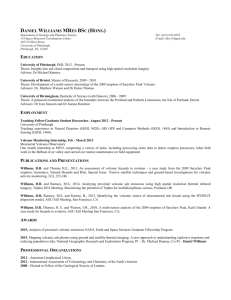Volcanoes - Jan Rasmussen.com
advertisement
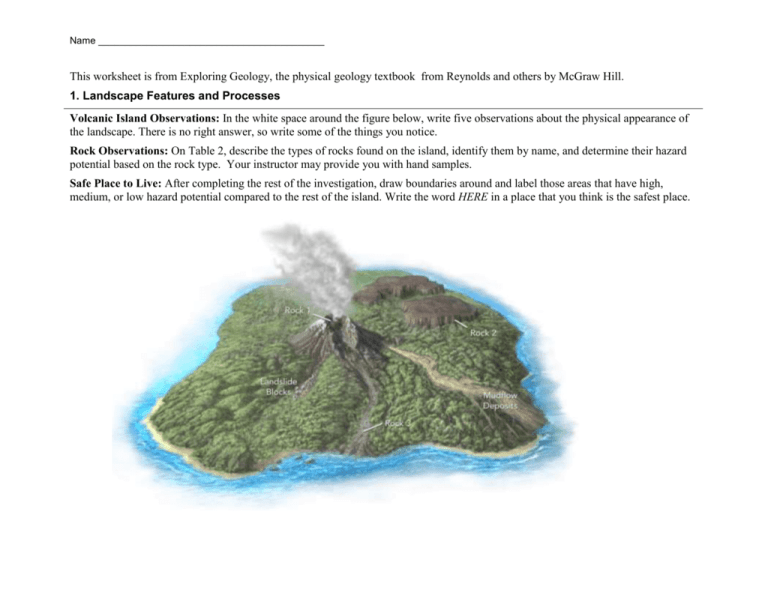
Name __________________________________________ This worksheet is from Exploring Geology, the physical geology textbook from Reynolds and others by McGraw Hill. 1. Landscape Features and Processes Volcanic Island Observations: In the white space around the figure below, write five observations about the physical appearance of the landscape. There is no right answer, so write some of the things you notice. Rock Observations: On Table 2, describe the types of rocks found on the island, identify them by name, and determine their hazard potential based on the rock type. Your instructor may provide you with hand samples. Safe Place to Live: After completing the rest of the investigation, draw boundaries around and label those areas that have high, medium, or low hazard potential compared to the rest of the island. Write the word HERE in a place that you think is the safest place. 2. Observations and Identification of Rocks Types on Island Study the photographs below and identify key attributes to describe each rock type, such as whether the rock is composed of fragments. From these attributes and rock types, infer what kind of eruption probably formed the rock type. Rock 1 Rock 1: This image shows obsidian, a glassy igneous rock of felsic composition. This example has gray obsidian with abundant vesicles and dark obsidian with few vesicles. The different types of obsidian occur in layers formed by flow when the rock was molten. From these characteristics and the location of the sample, infer what kind of eruption probably formed this rock type. Rock 2 Rock 3 Rock 2: This image shows a welded tuff, with flattened pieces of light-colored pumice in a pinkish matrix of compacted ash, crystals, and rock pieces. From these characteristics, infer what kind of eruption probably formed this rock type. Although not important for this question, this rock does not seem to have been recently formed. Rock 3: This image shows a volcanic breccia composed of angular pieces of light- to dark-gray igneous rock in a matrix of powdery volcanic ash and broken rock pieces. Many of the pieces are glassy, vesicular, and somewhat banded. The volcanic deposit has baked the underlying soil. From these characteristics and the location of the sample, infer what kind of eruption probably formed this rock unit. Name __________________________________________ Style of eruption: a. eruption of a low-viscosity, basaltic lava flow b. eruption of high-viscosity lava in a dome c. dome collapse that forms volcanic breccia d. eruption of a pyroclastic flow that forms a thick and hot deposit e. slow settling of ash from a tall eruption column forming a nonwelded tuff Style of eruption: Style of eruption: a. eruption of a low-viscosity, basaltic lava flow b. eruption of high-viscosity lava in a dome c. dome collapse that forms volcanic breccia d. eruption of a pyroclastic flow that forms a thick and hot deposit e. slow settling of ash from a tall eruption column forming a nonwelded tuff a. eruption of a low-viscosity, basaltic lava flow b. eruption of high-viscosity lava in a dome c. dome collapse that forms volcanic breccia d. eruption of a pyroclastic flow that forms a thick and hot deposit e. slow settling of ash from a tall eruption column forming a nonwelded tuff 1329935282368 1329935123353 3. Read the following newspaper account and select the number of the type of volcanic hazard and match it with the letter of the evidence and extent of hazard from the table below. 3. Assessing Volcanic Hazards of the Island Read the newspaper account of the eruptive history of this volcano. Propose at least four possible hazards expected from its eruptive history. Describe evidence for the hazard and describe how extensive each hazard might be and whether it can be minimized. Volcanic Hazard Evidence and Extent of Hazard 3 1. Lahar a. The first eruption was accompanied by clouds of ash that rose thousands of meters into the air covering nearby areas with a heavy deposit of ash. 2. Pyroclastic Flow b. Snow and ice cover the top of the volcano. When the volcano erupts, ice and snow can melt rapidly sending mud into nearby areas. 3. Ash Fall c. Due to the explosive eruption of the volcano, rock and debris slide down the side of the volcano at incredibly high speeds and high temperatures burying nearby areas with a mix of igneous rocks, volcanic ash, and broken rock pieces. 4. Dome Collapse and d. As the top or sides of a volcano become over steepened they collapse and break into a jumble of blocks Pyroclastic Flow and ash that flow downhill. The following is a newspaper account: Volcano Erupts! The Juanannita volcano began erupting in early September of 1952, and dozens of small eruptions have occurred since that time. For 10 years before the 1952 eruption, plumes of white steam often were observed rising from the summit of the crater. In the summer of 1952, local inhabitants reported an increase in the output of steam and an increased smell of sulfur. The first eruption was a single explosive burst that lasted about three hours and was accompanied by clouds of ash that rose thousands of meters into the air. Heavy ash fell around the volcano, and a light dusting of ash was reported on adjacent islands up to 20 kilometers away. The eruption melted snow and ice high on the crater forming a mudflow that moved along stream channels and inundated many areas in valleys downstream from the volcano. After the main eruption, a lava dome started growing in the crater. All subsequent eruptions have been smaller and of a different style. They have been similar to one another. In each eruption, a cloud of ash and rocks that is mostly restricted to stream channels moves rapidly downhill. After each eruption, geologists noted that one side of the dome in the crater had collapsed into a pile of ash and rocks.



